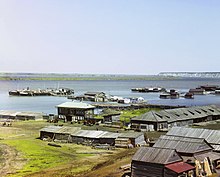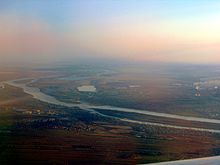Irtysh
| Irtysh | |
|---|---|
 Irtysh watershed | |
| Location | |
| Country | Mongolia, China, Kazakhstan, Russia |
| Cities | Oskemen, Semey, Pavlodar, Omsk, Tobolsk, Khanty-Mansiysk |
| Physical characteristics | |
| Source | Altai Mountains |
| • location | Altay Prefecture, China |
| • coordinates | 47°52′39″N 89°58′12″E / 47.87750°N 89.97000°E |
| • elevation | 2,960 m (9,710 ft) |
| Mouth | Ob |
• location | Khanty-Mansiysk, Russia |
• coordinates | 61°04′52″N 68°49′49″E / 61.08111°N 68.83028°E |
• elevation | 20 m (66 ft) |
| Length | 4,248 km (2,640 mi) |
| Basin size | 1,643,000 km2 (634,000 sq mi) |
| Discharge | |
| • average | 2,150 m3/s (76,000 cu ft/s) (near Tobolsk) |
| Basin features | |
| Progression | Ob→ Kara Sea |
The Irtysh[note 1] is a river in Russia, China, and Kazakhstan. It is the chief tributary of the Ob and is also the longest tributary river in the world.
The river's source lies in the Mongolian Altai in Dzungaria (the northern part of Xinjiang, China) close to the border with Mongolia.
The Irtysh's main tributaries include the Tobol, Demyanka and the Ishim. The Ob-Irtysh system forms a major drainage basin in Asia, encompassing most of Western Siberia and the Altai Mountains.
Geography



From its origins as the Kara-Irtysh (Black Irtysh) in the Mongolian Altay mountains in Xinjiang, China, the Irtysh flows northwest through Lake Zaysan in Kazakhstan, meeting the Ishim and Tobol rivers before merging with the Ob near Khanty-Mansiysk in western Siberia, Russia after 4,248 kilometres (2,640 mi).
The name Black Irtysh (Kara-Irtysh in Kazakh, or Cherny Irtysh in Russian) is applied by some authors, especially in Russia and Kazakhstan, to the upper course of the river, from its source entering Lake Zaysan. The term White Irtysh, in opposition to the Black Irtysh, was occasionally used in the past to refer to the Irtysh below lake Zaysan;[3] now this usage is largely obsolete.
Main tributaries
The largest tributaries of the Irtysh are, from source to mouth:
Economic use
In Kazakhstan and Russia,
On the Kazakhstan section of the river there are presently three major

Three dams have been constructed on the Chinese section of the Irtysh as well: the Keketuohai (可可托海) Dam (47°10′51″N 89°42′35″E / 47.18083°N 89.70972°E), the Kalasuke (喀腊塑克) Dam (47°08′14″N 88°53′15″E / 47.13722°N 88.88750°E),[5][6] and the
The Northern river reversal proposals, widely discussed by the USSR planners and scientists in the 1960s and 1970s, would send some of the Irtysh's (and possibly Ob's) water to the water-deficient regions of central Kazakhstan and Uzbekistan. Some versions of this project would have seen the direction of flow of the Irtysh reversed in its section between the mouth of the Tobol (at Tobolsk) and the confluence of the Irtysh with the Ob at Khanty-Mansiysk, thus creating an "Anti-Irtysh".[7] While these gigantic
In China, a short canal was constructed in 1987 (water intake at 47°26′31″N 87°34′11″E / 47.44194°N 87.56972°E) to divert some of the Irtysh water to the
Cities

Major cities along the Irtysh, from source to mouth, include:
- in China: Fuyun, Beitun, Burqin
- in Kazakhstan: Aksu, Pavlodar
- in Russia: Omsk, Tara, Tobolsk, Khanty-Mansiysk
Bridges
Seven railway bridges span the Irtysh. They are located in the following cities:
- About 15 km downstream from Zyryanovsk)
- Oskemen
- Semey, on the Turkestan–Siberia Railway
- Nur-Sultan to Barnaul)
- near Cherlak, on the Middle Siberian rail line (Среднесибирская магистраль)
- Omsk, on the Trans-Siberian Railway. Opened in 1896, this is the oldest bridge on the river.
- Tobolsk, on the Tyumen-Surgut line
As the
Numerous highway bridges over the Irtysh exist in China, Kazakhstan, and Russia.
The last bridge downstream on the Irtysh, a highway bridge opened in 2004, can be found at Khanty-Mansiysk, right before the river's confluence with Ob.
History

A number of
In the 15th and 16th centuries the lower and middle courses of the Irtysh lay within the Tatar Khanate of Sibir; its capital, Qashliq (also known as Sibir) was located on the Irtysh a few kilometres upstream from the mouth of the Tobol (where today's Tobolsk is situated).
The Khanate of Sibir was conquered by the Russians in the 1580s. The Russians started building fortresses and towns next to the sites of former Tatar towns; one of the first Russian towns in Siberia (after Tyumen) was Tobolsk, founded in 1587 at the fall of the Tobol into the Irtysh, downstream from the former Qashliq.[14] Farther east, Tara was founded in 1594, roughly at the border of the taiga belt (to the north) and the steppe to the south.[15]
In the 17th century the
The Chinese
The situation in the borderlands in the mid-19th century is described in a report by A. Abramof (
The border between the Russian and the Qing empires in the Irtysh basin was established along the line fairly similar to China's modern border with Russia and Kazakhstan by the
Cultural references
The Irtysh River serves as a backdrop in the epilogue of
Other uses
- FC Irtysh Omsk, a soccer team in Omsk, Russia.
- FC Irtysh Pavlodar, a soccer team in Pavlodar, Kazakhstan.
- Irtysh (Иртыш), a Russian military hospital ship, used at the Bering Strait Swim 2013.
See also
Notes
- : Эйәртеш, Eya’rtes’
Citations
- ^ [1] Bitig Kz: ´“Name of the “Irtysh” river.´, 20 September 2020
- The Secret History of the Mongols
- ^ Abramof 1865, p. 65, and the map before p. 65.
- ^ "Waterways World: Latest". Archived from the original on 2011-07-26. Retrieved 2010-02-07.
- ^ "Xinjiang Kalasuke 140MW Hydroelectric Project".
- ^ 考察调研组专家考察在建的喀腊塑克水利枢纽工程 (A group of experts visits the Kalasuke Dam), 2010-08-05
- ISBN 978-9251043097(An English translation of the original paper published in the Vestnik Moskovskogo Universiteta in 1979).
- ^ KAZAKHSTAN: ENVIRONMENTALISTS SAY CHINA MISUSING CROSS-BORDER RIVERS Archived 2017-11-07 at the Wayback Machine. By Gulnoza Saidazimova, 7/16/2006.
- ^ Sievers, Eric W. (2002), "Transboundary Jurisdiction and Watercourse Law: China, Kazakhstan and the Irtysh" (PDF), Texas International Law Journal, 37 (1), archived from the original (PDF) on 2013-09-21, retrieved 2013-09-19
- ^ Kulikov, Evgeny Vyacheslavovich (Куликов Евгений Вячеславович) (2013-08-23), Adapting of fisheries management to the changing Irtysh water basin hydrological regime, archived from the original on 2013-09-25, retrieved 2013-09-21
- ISBN 978-0-674-03109-8.
- ISBN 978-0-231-13924-3.
- ISBN 9780521477710
- ISBN 978-0275956486
- ^ Forsyth 1994, pp. 37, 125–127
- ^ Forsyth 1994, p. 128
- ^ Abramof 1865, p. 65
- ^ Abramof 1865, p. 66
- ^ Abramof 1865, pp. 62–63; see also the border shown on the map before p. 65.
- ^ Articles 2 and 3 in the Russian text of the treaty
- ^ (See the map)
- ^ "The Lost Frontier – Treaty Maps that Changed Qing's Northwestern Boundaries_The Changing Borders". npm.gov.tw.
General literature
- Great Soviet Encyclopedia
- Abramof, A. (1865), "The lake Nor-Zaysan and its neighborhood", Journal of the Royal Geographical Society of London, 35, translated by John Michell: 58–69, JSTOR 3698078
External links
 Media related to Irtysh River at Wikimedia Commons
Media related to Irtysh River at Wikimedia Commons
